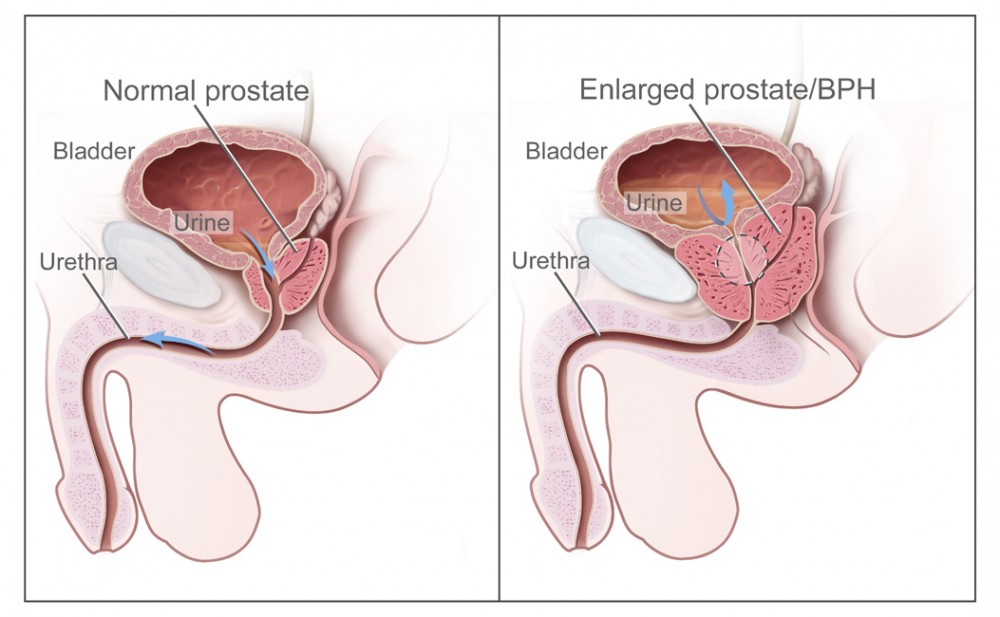ABOUT Benign Prostatic Hyperplasia - Symptoms and Treatment
Benign Prostatic Hyperplasia
Benign Prostatic Hyperplasia is a condition in which
the prostate gland gets larger, often making it difficult to urinate. It
usually affects men over 40 years of age. The condition can be managed by
medication, surgery, or other treatments.
There are two types of Benign Prostatic Hyperplasia:
non-cancerous and cancerous. Non-cancerous causes reduced urine flow in short
intervals, while cancerous causes frequent urination with no results in
decreased urine volume.
Non-cancerous BPH can be treated with medication that
works to decrease secretion or block production of testosterone in the body,
reduce the size of the prostate gland or shrink overactive tissue cells within
the gland.
Benign Prostatic Hyperplasia is a common condition that
affects up to 15% of men over the age of 40. Benign Prostatic Hyperplasia is a
type of prostate cancer found in about 9% of men over the age of 40, with about
1/100 returning after treatment with radiation therapy. Benign Prostatic
Hyperplasia is more common among African-Americans and Hispanics.
Cancer of the prostate occurs from increased cell
growth within the gland, which causes benign tumors called enlargement
prostatic cancers.
Although benign, enlargement prostatic cancers can
become malignant (cancerous) which is called malignant prostate cancer. The
disease is more common among African-Americans and Hispanics, with up to 6
million men living with this type of cancer in the United States.
Prostate cancer occurs almost exclusively in men over
60 years of age, however, it's one of the most common malignancies in black
men.
About 50% of malignant prostatic cancers are
hormone-refractory (non-responsive to hormonal therapy). This means that after
hormonal treatment there will be no improvement in symptoms or tumor size. And
the only way to treat these types of tumors is by surgery.
Signs and Symptoms
The main symptom of Benign Prostatic Hyperplasia is
difficulty in urinating.
Other symptoms include: burning or pain when urinating
especially at the beginning or end of urination, urgency to urinate, incomplete
emptying of the bladder, urinary leaks, blood in the urine.
Exams and Tests
Diagnosis begins with a physical exam. Imaging tests
like ultrasound (ultrasound pictures), computed tomography (CT) scan, and
magnetic resonance imaging (MRI) may be used to look for enlarged prostate
gland which can cause difficulty in urinating. A needle biopsy is often done to
determine if there are any cancerous cells within the enlarged prostate gland.
Benign Prostatic Hyperplasia is usually diagnosed by
changes of the prostate gland through a doctor's physical examination.
The doctor will look for an enlarged prostate gland on
an ultrasound of the prostate gland. If it has enlarged, the doctor also looks
to see if there are any changes in the shape of the gland or any nodules are
seen on an ultrasound of the prostate gland.
A doctor may have to use a needle biopsy to take a
small piece of more than one lobe of tissue from within the prostate.
This procedure can also be done with an endoscope that
guides a thin fiber-optic tube into the outer urethra which allows light
through, enabling imaging. The sample from the tissue is then sent to a lab for
analysis.
This disease can also be detected through urine tests
that can show abnormal levels of prostatic acid phosphatase. A blood test,
including a prostate-specific antigen test, may also indicate a higher risk of
Benign Prostatic Hyperplasia.
A doctor may or may not recommend a biopsy. A biopsy is
a surgical procedure in which a needle is used to remove a small piece of
tissue from the prostate gland to examine it under magnification with special
microscopes and help determine if there are any cancerous cells present.
What Is The Treatment?
Non-cancerous Benign Prostatic Hyperplasia can be
treated with medication that works to decrease secretion or block production of
testosterone in the body, reducing the size of the prostate gland or shrink
overactive tissue cells within the gland.
The main treatment for cancer of the prostate is
surgery for early localized disease and/or radiation therapy and brachytherapy
(high dose fractionated external beam radiotherapy) for later stages of
localized disease. Localized disease is cancer that stays in one spot and has
not spread to other parts of the body.
What Are Its Therapy And Surgery?
Treatment involves the removal of the enlarged prostate
gland followed by hormone therapy to reduce prostate-specific antigen (PSA)
levels. The therapy will reduce the size of the enlarged gland, decrease
secretion of hormones and raise PSA levels.
Following surgery, another procedure may be done known
as permanent stent placement, where a metal or plastic tube is inserted into
the urethra to maintain the functionality of the urethra while hormonal
treatment continues.
If cancer originates in one lobe but has spread to
other parts of the body, radiation therapy and/or brachytherapy will be used to
treat disease more than 90% of cancer cases are localized (<1%).

